Setsubun and Otafuku
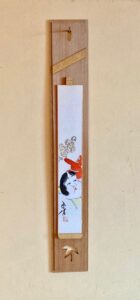
Tan-zaku, 短冊, short-volume, long narrow paste with painted color picture of masks of O-ta-fuku, お多福, O-much-fortune, and Saru-ta-hiko, 猿田彦, Monkey-ricefield-lad, shin-en-rei, 神苑例鈴, god-garden-bells, with long trailing five-color ribbons: signed, ?-kō, 香, ?-incense; L. 9.5 x 1.5 sun kujira-jaku. The scene is enacted each year on Setsu-bun, 節分, Season-divide, which occurs on February 2 or 3, the ideological last day of winter. Otafuku represents the abundance and fertility of spring dispelling the harshness of winter. The oni is not evil, but embodies aspects of nature that can bring destruction.
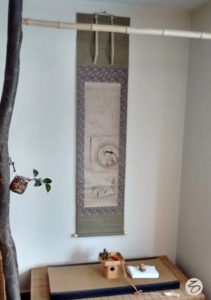
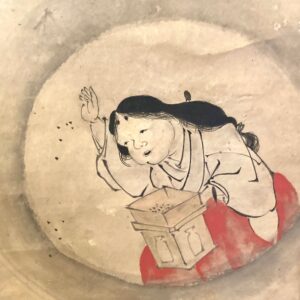
The round window may evoke the moon or the sun, as round windows are not common in Japanese architecture. Otafuku is a celestial being, as she is a manifestation of Ame-no-uzu-me no Mikoto, 天之鈿女命, Heaven-’s-ornament-woman’s Lady. Her name is also written, 天宇受賣命, Heaven-sky-turn-show-Lady. Uzume represents the turning of the heavens, and appears at the beginning of spring.
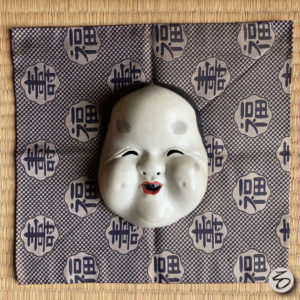
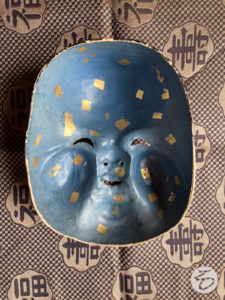
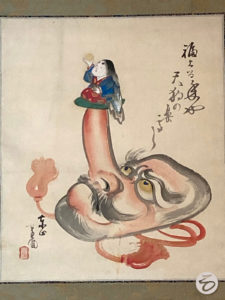
Depictions of a tengu and Saru-ta-hiko, 猿田彦, Monkey-ricefield-boy, are often quite similar in appearance. The golden eyes of the tengu denote that he is a deity, and the red cord shows that it is a mask. This author is able to read with little assurance the Kanji for fuku, 福, fortune, and ten-gu no hana, 天狗の鼻, heaven-dog.
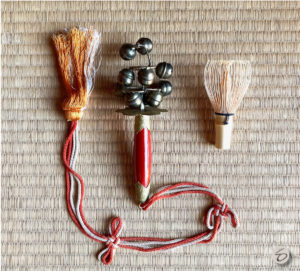
The bells are held in the right hand and twisted to ring the bells, just as the chasen in held in the right hand and briskly rinsed in water making the sound ‘sara-sara,’ and twisted to make tea. ‘Sara–sara’ is said to be the sound the wind makes in the reeds along a river. The actions of Setsubun take place in heaven along the Ama-no-kawa, 天の川, Heaven’s-river, the Milky Way. The pictured shinenrei is a bit atypical, as it has long cords, whereas the more familiar cluster of bells has long ribbons of five primarily colors: purple, red, white, yellow, green. The tassel is also unusual, but does seem to correspond with the thread around the chasen. There are pictures and writings that may not be suitable for the tokonoma in the Tearoom, but can be displayed in the machi-ai, 待合, wait-gather, before entering the Tearoom.

Tan-zaku, 短冊, short-volume, long narrow paste with painted color picture of masks of O-ta-fuku, お多福, O-much-fortune, and Saru-ta-hiko, 猿田彦, Monkey-ricefield-lad, shin-en-rei, 神苑例鈴, god-garden-bells, with long trailing five-color ribbons: signed, ?-kō, 香, ?-incense; L. 9.5 x 1.5 sun kujira-jaku.
Length of the standard tanzaku is 9.5 sun kane-jaku, the widths are 2 and 2.5 sun kane-jaku. It should be understood that there are many variations on almost anything.
The long narrow format of the tanzaku lends itself extremely suited to the narrow wooden posts of Japanese wood frame construction. There are two general standards for a post, hashira, 柱, in domestic architecture: the width of the post is 3 are 4 sun kane-jaku. square with slightly chamfered corners. The pictured board hanger was made to accommodate a tanzaku of 2 sun kane-jaku, as can be seen in the width of the bamboo support piece at the bottom.
The open-work, sukashi, 透かし, motif is of leaves of sasa, 笹, bamboo grass. There may be wordplay on sasa-e, 笹絵, bamboo-picture, as sasae, 支え, is a common word that means ‘support.’
There are wooden plank hangers made specially for mounting the long narrow pasteboard pieces, tan-zaku kake, 短冊掛, short-volume hanger. The familiar display board is made of sugi, 杉, cedar; L. 20 x 3 sun kane-jaku. 20 sun kane-jaku transposes to 16 sun kujira-jaku. The number 16 has a greater numerological symbolism.
The measurement of 9.5 sun kujira-jaku transposes to 11.875 sun kane-jaku. It is obvious that the tanzaku is measured with the kujira-jaku, whereas the wooden post and the tanzaku board hanger are measured with the kane-jaku. In a relatively obscure manner, the various elements relate to each other 8:10, which is identified with concept of ya-ta, 八咫, eight-span, symbolic of Infinity in Space.
Length of the standard tanzaku is 9.5 sun kane-jaku, the widths are 2 and 2.5 sun kane-jaku. It should be understood that there are many variations on almost anything.
The long narrow format of the tanzaku lends itself extremely suited to the narrow wooden posts of Japanese wood frame construction. There are two general standards for a post, hashira, 柱, in domestic architecture: the width of the post is 3 are 4 sun kane-jaku. square with slightly chamfered corners. The pictured board hanger was made to accommodate a tanzaku of 2 sun kane-jaku, as can be seen in the width of the bamboo support piece at the bottom.
The open-work, sukashi, 透かし, motif is of leaves of sasa, 笹, bamboo grass. There may be wordplay on sasa-e, 笹絵, bamboo-picture, as sasae, 支え, is a common word that means ‘support.’
There are wooden plank hangers made specially for mounting the long narrow pasteboard pieces, tan-zaku kake, 短冊掛, short-volume hanger. The familiar display board is made of sugi, 杉, cedar; L. 20 x 3 sun kane-jaku. 20 sun kane-jaku transposes to 16 sun kujira-jaku. The number 16 has a greater numerological symbolism.
The measurement of 9.5 sun kujira-jaku transposes to 11.875 sun kane-jaku. It is obvious that the tanzaku is measured with the kujira-jaku, whereas the wooden post and the tanzaku board hanger are measured with the kane-jaku. In a relatively obscure manner, the various elements relate to each other 8:10, which is identified with concept of ya-ta, 八咫, eight-span, symbolic of Infinity in Space.
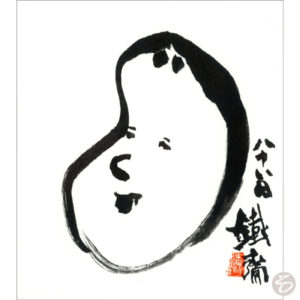
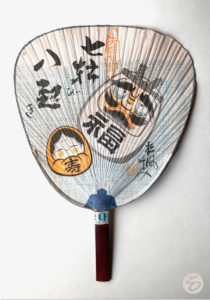
The shape of the fan is like the outlines of both doll figures, which is the hisago, 瓢, gourd. The bottle gourd, hyō-tan, 瓢箪, gourd-basket, is one of the most sacred objects in Taoism. Many uchiwa have the shape of the gourd.
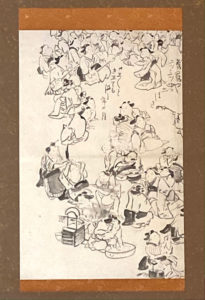
In spite of Otafuku’s plump appearance, which modern people regard as less than pretty, she was once regarded as beautiful as it has the figure identified with abundance and fertility. One can appreciate such beauty more greatly by looking at the old picture scrolls of the Gen-ji Mono-gatari, 源氏物語, Origin-clan Thing-word, narrative.
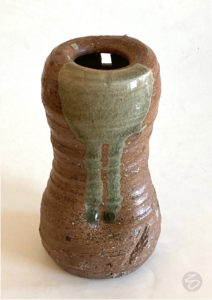






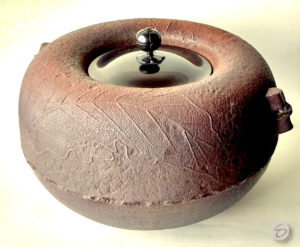
The word ubaguchi is associated with Oto-go-ze, 乙御前, Second-honored-before, who is one of Amenouzume’s manifestations. The kettle’s name kashiwa-ba refers to the raised design of a large oak leaf on either side of the kama, which is to imply kashiwa-de, 柏手, oak-hands. Kashiwa-de is also the term for clapping one’s hands to get the attention of a deity at a Shintō shrine. There is a famous incident in which a valiant warrior named Kashiwade no Hanoshi, 膳泣巴提使, Tray-weep-comma-carry messenger, killed a menacing tiger in a bamboo grove near a waterfall in Korea. The above-pictured kama has kantsuki, 鐶付, metal ring-attach, that are in the form of pieces of bamboo, and the kettle is full of water. There are often multiple and somewhat obscure meanings identified with many kama.
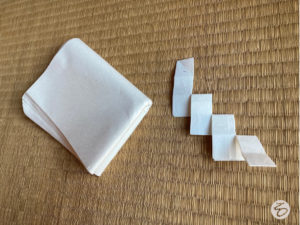
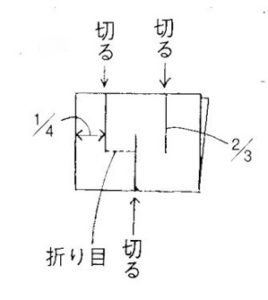
Kami kama-shiki, 紙釜敷, paper kettle-spread, is a pack of 18 to 40 sheets of paper folded twice in opposite directions, used to rest the kama when removed from the hearth to attend to the charcoal fire. The kami kamashiki was the original kai-shi, 懐紙, heart-paper, that Rikyū cut approximately in half to be less extravagant to be used personally as kaishi. However the large kaishi are used with the kama, and are often displayed in the tokonoma to support a kō-gō, 香合, incense-gather.
A shi-de, 四手, four-hand, is a cut and folded doubled sheet of paper to form a zigzag pendant that is displayed to invite Shintō spirits. In Chanoyu, when presenting mei-sui date, 名水点, name-water presentation, which features water from a famous source put into a mizu-sashi, 水指, water-indicate, that is adorned with several shide attached to a straw rope, shime-nawa, 注連縄, pour-along-rope. The shime-nawa is often wrapped around a display stand for Tea utensils for the New Year. A shide is easily made: cut a sheet of women’s kai-shi, 懐紙, in half, fold it in half, from the middle of the folded edge, cut in two/thirds, from the opposite edge on both sides of the center cut, cut in two/thirds, fold down the paper from the cuts. When making a shide, the piece is folded three times, just as the kami kamashiki is folded three times. It may be that displaying the kami kamashiki in the tokonoma is to represent the shide at a Shintō shrine. When Amaterasu was coaxed out from the Cave of Heaven, she was offered paper streamers that in time became paper shide.
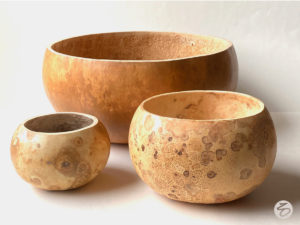
Each was cut for a particular use: the largest is for holding charcoal, which Rikyū preferred as a sumi-tori, 炭斗, charcoal-measure, for use with the ro; full diam. 9 sun kane-jaku. The gourd may be lacquered black on the interior. The fukube sumitori is used most frequently for Ro-biraki, 炉開, Hearth-opening, for the first Tea of the ro season in November. The middle size gourd is suitable for use as a ken-sui, 建水, build-water, which is one of the prime uses for the dried gourd. The small gourd is used as a hi-ire, 火入, fire-receptacle, for the tabako bon, 煙草盆, smoke-grass tray. It is interesting to note that with a burning piece of charcoal inside, the gourd remains only a little warm to the touch.
Because a gourd is creation of nature, it is difficult to have a gourd sumitori that has the exact same measurements of Rikyū’s fukube with a diameter of 9 sun kane-jaku. Gourds have been used to hold charcoal for hundreds of years, and often they are fashioned to resemble Daruma. Daruma is often a companion to Otafuku, and as her name includes the word ‘fuku.
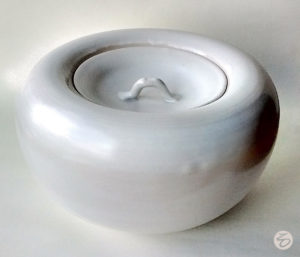
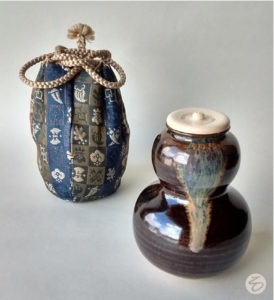
An appropriate ma-tcha, 抹茶, powdered tea, for Setsubun might be; ‘Fuku Mukashi,’ 福昔, Fortune Past, choice of Tan-tan-sai, 淡々斎, Light-light-abstain, XIV Iemoto, Urasenke, by I-ppō-dō, 一保堂, One-provision-hall, Kyōto.
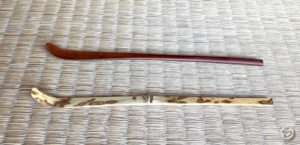
Wood chashaku, ‘shin,’ 真, true, style, ume, 梅, Japanese apricot, Prunus mume; L. 6 sun kane-jaku. Setsubun occurs at the time in February, when the ume are blooming in Kyōto.
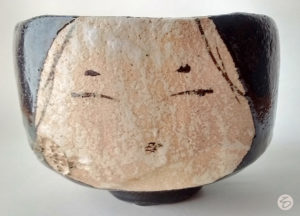

The chawan form is modeled after a kama owned by O-da Nobu-naga, 織田信長, Weave-ricefield Faith-long, named Otogoze, as it had a sunken mouth, a somewhat unflattering observance of an older woman’s sunken mouth. See the ‘Otogoze’ kama pictured above. The ‘Otogoze’ chawan is one of a group of chawan created by Kōetsu, that he called fukuro, 袋, bag.
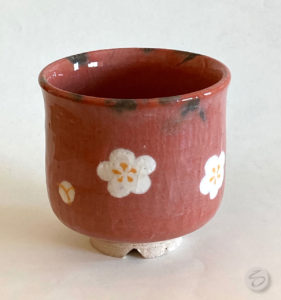
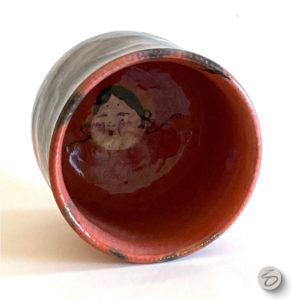
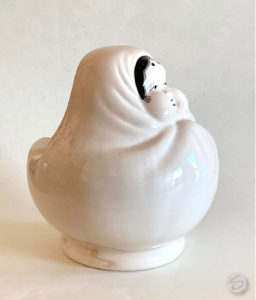
In Japan, a typical snowman is made to look like Daruma. While sitting for nine years, Daruma lost the use of his legs, so that he is pictured without them. A hand-warmer is often presented to the guests in cold weather, and would be given before preparing usu-cha, 薄茶, thin-tea. Smoking articles are presented to the guest, such as the typical tabako bon, 煙草盆, smoke-grass tray.
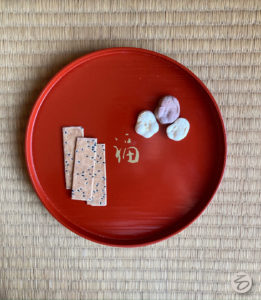
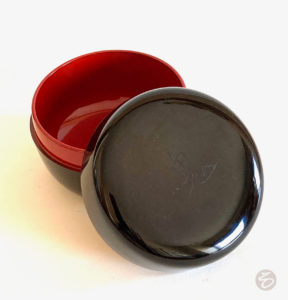
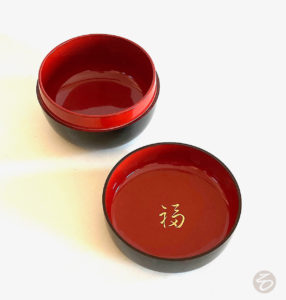
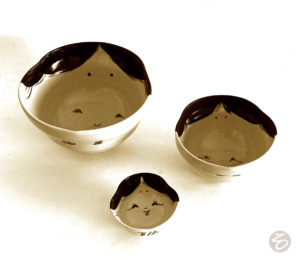
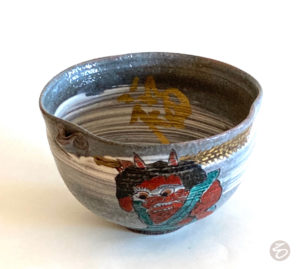
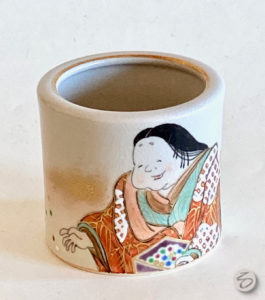
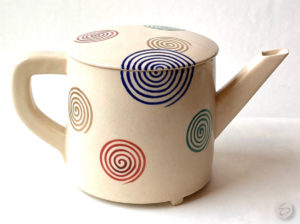
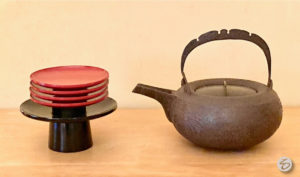
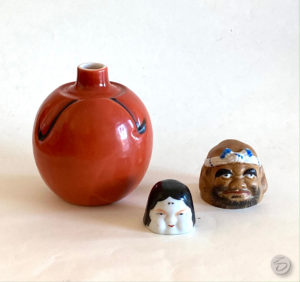
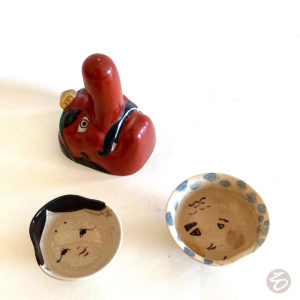
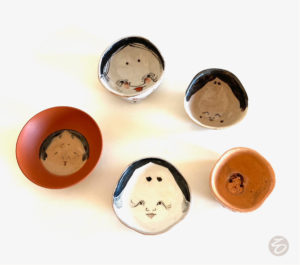
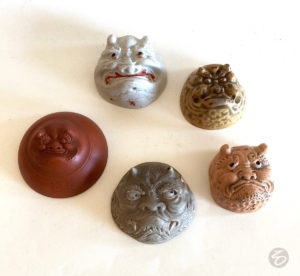
Various sake cups with the interior decorated with the face of O-ta-fuku, お多福, O-much-fortune, that have the molded relief face of an oni, 鬼, demon, on the opposite side. The largest cup diameter is 2.2 sun kane-jaku. These little cups embody the motto of Setsu-bun, 節分, Season-divide: “oni wa soto fuku wa uchi,” 鬼は外福は内, demon out fortune in. The demon’s horns and chin form a tripod for stability. The tiny face inside the small orange-tan cup is as small as a mame, 豆, bean, as the word mame also means small. Traditional sake cups are small, as one should drink the entire contents in one or more sips, so that the sake stays warm.
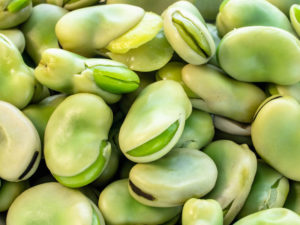
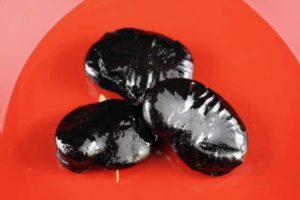
The name sora, sky, comes from the trait of the stalks stand upright toward the sky. One must be very careful eating broad beans, as they can be highly toxic to some people, and even cause death. The cooked and cured beans are less treacherous. Because of their deathly potential, the ancients around the world associated broad beans with death, and displayed them at funerals.
Raw or cooked, the bean with and without its skin does look a little like Otafuku. Actually, with the skin removed, the bean has a small pointed ‘nose’ which could evoke images of the oni. Making Otafuku mame includes long cooking, with sugar and soy sauce which gives its black color. Why they are so-named Otafuku remains a mystery, so far.
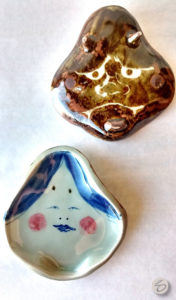
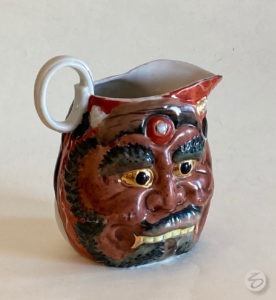
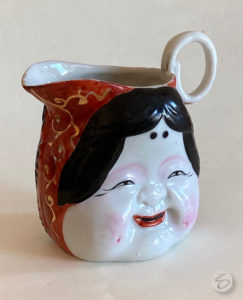
Two faces of a translucent porcelain pitcher with raised features and colorful glaze designs of an oni, 鬼, demon, and O-ta-fuku, お多福, O-much-fortune, Ban-ko-yaki, 萬古焼, Ten thousand-old-fired; H. 4 sun kane-jaku.
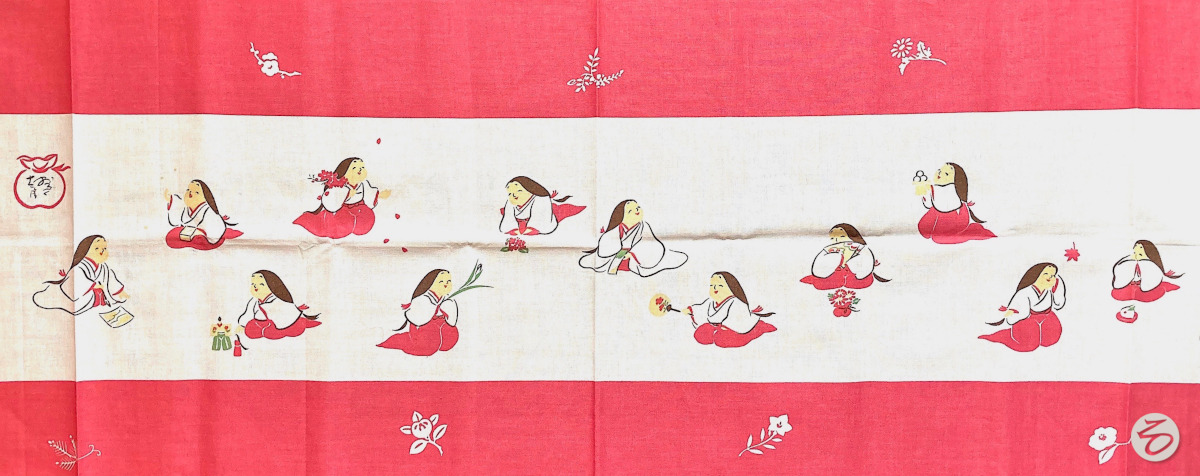
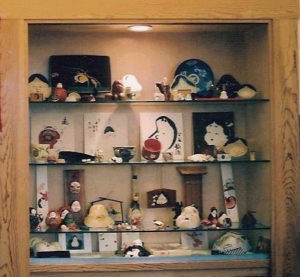
For more on Setsubun and Otafuku, see also: Setsubun and Otafuku (article), Setsubun and Risshun (article), Setsubun Extra (article), Tea in February (article), Setsubun Lecture (video), Setsubun Tea Gathering (video).

